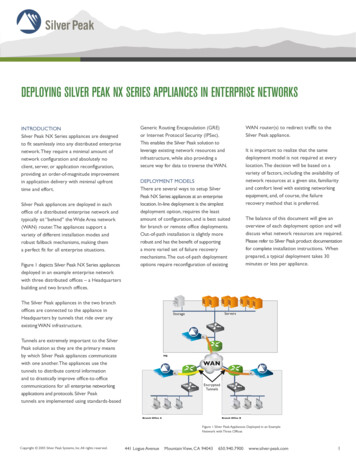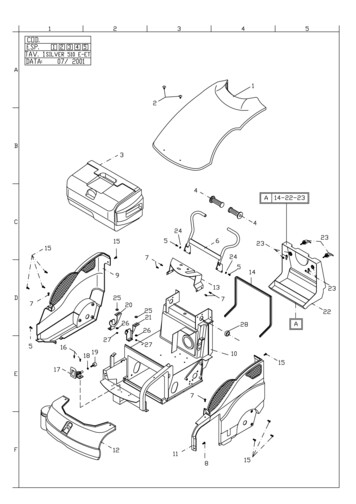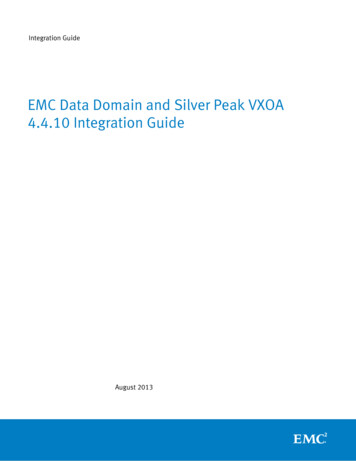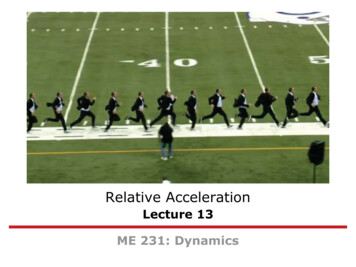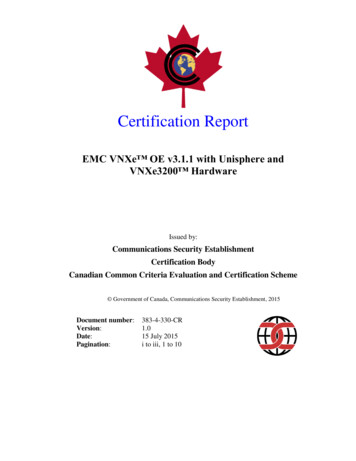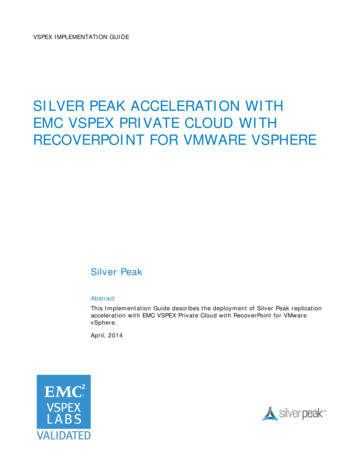
Transcription
VSPEX IMPLEMENTATION GUIDESILVER PEAK ACCELERATION WITHEMC VSPEX PRIVATE CLOUD WITHRECOVERPOINT FOR VMWARE VSPHERESilver PeakAbstractThis Implementation Guide describes the deployment of Silver Peak replicationacceleration with EMC VSPEX Private Cloud with RecoverPoint for VMwarevSphere.April, 2014
ContentsCopyright 2014 Silver Peak Systems, Inc. Silver Peak Systems, the SilverPeak logo, Network Memory, and Silver Peak NX-Series are trademarks ofSilver Peak Systems, Inc.EMC2, EMC, the EMC logo, VSPEX are registered trademarks or trademarks ofEMC Corporation in the United States and other countries.2
ContentsContentsChapter 1Introduction6Purpose of this guide . 6Business value . 6Scope . 7Audience. 7Terminology . 7Solution tested . 7Chapter 2Solution Architecture Overview8Solution Overview . 8Silver Peak VXOA Overview . 8Architecture . 8Sizing . 9Obtaining Silver Peak Software . 10When Should Silver Peak be Deployed with RecoverPoint . 10Chapter 3Implementation Process Overview11Before You Begin . 11Chapter 4Installation and Configuration12Silver Peak VRX Installation . 12Deploy the Velocity Replication Accelerator OVF template . 12Establish Connectivity to the Virtual Appliance . 14Complete the Appliance Manager Initial Configuration Wizard . 15Silver Peak Best Practices. 17Encryption . 17Correcting Loss . 17RecoverPoint Configuration . 18Add a New Default Gateway. 18Chapter 5Validating Silver Peak Operation20Measuring Performance with Silver Peak . 20Silver Peak Performance. 20Chapter 6Testing and Validation21Silver Peak Testing and Validation with RecoverPoint. 21Test Methodology . 21Test Suite Overview . 213
ContentsvRPA Test Results . 21RPA Test Results . 23RecoverPoint Throughput across Multiple Latencies . 24Appendix AUSEFUL LINKS25Appendix BIP Configuration Worksheet26FiguresFigure 1.RecoverPoint and Silver Peak Solution Overview . 8Figure 2.Silver Peak VXOA Architecture . 9Figure 3.VMware vSphere client. 12Figure 4.Adding storage for the Silver Peak virtual machine . 13Figure 5.Selecting storage type . 13Figure 6.Mapping network to network adapter . 13Figure 7.Finish Silver Peak OVF deployment . 14Figure 8.Power on Silver Peak virtual machine . 14Figure 9.Silver Peak console . 15Figure 10. Silver Peak DHCP . 15Figure 11. Silver Peak static IP address . 15Figure 12. Silver Peak appliance manager login . 16Figure 13. Silver Peak configuration wizard . 16Figure 14. Silver Peak Modify Tunnel Window . 17Figure 15. Silver Peak WAN Loss % Chart . 17Figure 16. Accelerated Data Flow Diagram . 18Figure 17. RecoverPoint login. 19Figure 18. RecoverPoint Gateway Configuration . 19Figure 19. RecoverPoint IP Version . 19Figure 20. Confirm RecoverPoint New Gateway. 19Figure 21. Silver Peak Flow Performance . 20Figure 22. Silver Peak Throughput Chart . 20Figure 23. vRPA/VRX-4 Test Environment . 22Figure 24. vRPA Test Results with 0.1% Loss . 22Figure 25. vRPA Test Results with 1% Loss . 22Figure 26. RPA/VRX-8 Test Environment. 23Figure 27. RPA Test Results with 0.1% Loss . 23Figure 28. RPA Test Results with 1% Loss. 24Figure 29. RPA Throughput across Multiple Latencies. 244
ContentsTablesTable 1.Terminology . 7Table 2.Silver Peak Replication Accelerator Models . 95
Chapter 1 IntroductionChapter 1 IntroductionPurpose of this guideThis document provides detailed configuration steps and best practices fordeploying Silver Peak replication acceleration software with EMC RecoverPointfor data protection across any network. This document builds on the VSPEXProven Architecture for RecoverPoint, EMC document #H12298. Test andvalidation results are also included in Chapter 6.Business valueEMC RecoverPoint is a data protection solution that provides local, and remotecontinuous data protection, allowing for any point-in-time data recovery. Inthe event of data loss, or corruption, data can be recovered across arrays andapplications to a consistent state. This allows applications to be quicklyrestarted, resulting in shorter downtime.The VSPEX Private Cloud solution for VMware vSphere with EMC VNX and EMCRecoverPoint is a highly scalable, building block solution that has beenvalidated for configurations up thousands of virtual machines.While EMC RecoverPoint provides an efficient replication solution, it is subjectto limitations created by the Wide Area Network (WAN). When the WANconnecting the two replication units has latency, packet loss or out-of-order,or limited bandwidth, replication throughput can be adversely affected causingmissed Recovery Point Objectives and potentially failed replication. Either ofthese expose the business to additional risk in the event or a recovery to thereplica.Silver Peak develops data center class replication acceleration software thatfixes the problems that exist on the WAN, enabling more data to be replicated,in less time, and over longer distances. Silver Peak’s Virtual Acceleration OpenArchitecture (VXOA) can be deployed as virtual software (VX or VRX) on anyhypervisor or as a hardware appliance (NX). VXOA solves WAN problems bydeduplicating and compressing replication traffic, repairing dropped and outof-order packets, and overcoming the effects of latency.When combined with VSPEX for RecoverPoint, Silver Peak software enablescustomers to meet their RPOs regardless of WAN bandwidth, latency, orquality.6
Chapter 1 IntroductionScopeThis guide is limited to the installation and configuration of the Silver Peaksoftware, and changes that need to be made to a functioning RecoverPointenvironment. This document does not cover the installation or initialconfiguration of RecoverPoint. For more information on deploying RecoverPointplease see the EMC VSPEX with EMC RecoverPoint for VMware vSphere 5.5Design and Implementation Guide.AudienceThis document is intended for storage architects, IT engineers, storageadministrators, professional services engineers, virtual administrators, andSAN administrators.TerminologyThis Implementation Guide includes the following terminology.Table 1.TerminologyTermDescriptionRPORecovery Point ObjectivevRPAVirtual RecoverPoint ApplianceRPARecoverPoint ApplianceVXOAVirtual Acceleration Open ArchitectureVRXVelocity Replication AcceleratorFECForward Error CorrectionLANLocal Area NetworkWANWide Area NetworkCRRRecoverPoint Continuous Remote ReplicationSolution testedSilver Peak and EMC tested a combination of Silver Peak VRX replicationacceleration software with physical and virtual RecoverPoint appliancesreplicating across simulated WAN connections with varying amounts of packetloss and latency. For more information on the test environment see AppendixA.7
Chapter 2 Solution Architecture OverviewChapter 2 Solution Architecture OverviewSolution OverviewSilver Peak software is deployed as a virtual machine on the LAN. While SilverPeak software supports deployment across several hypervisors, this documentfocuses on VMware. When deployed with RecoverPoint, Silver Peak uses asingle IP address and network connection to accelerate RecoverPointreplication, CRR. For this deployment no network changes need to be made,as all redirection will be performed by the RecoverPoint appliance.RecoverPointVNXRecoverPoint1VMware vSpherePrimary Data CenterVMware vSphereVNXSecondary Data CenterFigure 1. RecoverPoint and Silver Peak Solution OverviewSilver Peak VXOA OverviewArchitectureSilver Peak provides a robust WAN optimization solution that addresses thebandwidth, latency, and packet loss issues that are common to mostenterprise environments. Silver Peak's optimization techniques are allperformed in real-time and primarily at the network (IP) layer to ensuremaximum performance across the widest range of applications and WANenvironments.8
Chapter 2 Solution Architecture OverviewFigure 2. Silver Peak VXOA ArchitectureSilver Peak appliances leverage the following Virtual Acceleration OpenArchitecture (VXOA) technology components to accelerate all enterpriseapplications in a secure and reliable fashion:Network Memory: Silver Peak's solution for disk-based WAN deduplication.Network Memory inspects all traffic that is sent between clients and servers,storing information as a local instance in Silver Peak appliances. Repetitiveinformation is delivered locally rather than sent across the WAN, improvingapplication performance and WAN utilization. Cross-flow payload and headercompression provide additional gains on first-time data transfers and nonrepetitive traffic.Network Integrity: Silver Peak employs a variety of real-time techniques toaddress packet delivery issues common to shared WAN technologies such asMPLS and Internet connections. These include adaptive Forward ErrorCorrection (FEC) and Packet Order Correction (POC) to overcome dropped andout-of-order packets, and advanced Quality of Service (QoS) techniques toprioritize traffic and guarantee network resources.Network Acceleration: Silver Peak mitigates the impacts of latency across theWAN by using various TCP acceleration techniques, like adjustable windowsizing and selective acknowledgements. These tools help to overcome inherentchattiness that can otherwise hamper application performance across a WAN.Encryption: Silver Peak can encrypt network traffic using an AES-256 IPsecVPN. Any traffic sent between Silver Peak software instances can beaccelerated and encrypted at wire speed.Virtual Deployment Options: Silver Peak can be deployed as a physical appliance(NX) or a virtual instance (VX/VRX). Silver Peak’s virtual products can bedeployed on any hypervisor (VMware, Microsoft Hyper-V, Xen, and KVM) andon any server hardware that meets the minimum requirements.SizingVRX replication acceleration software is typically sized based on the availableWAN bandwidth for data protection traffic, including replication, backup, anddata migration. Each VRX model has a limit on the amount of WAN bandwidththat it will support. The VXOA software that powers VRX can also be limited inthe amount of bandwidth that will be used on the WAN.For example, if you have 100 Mbps of WAN bandwidth, but only 40 Mbps isavailable for replication traffic, a VRX-4 will be used with a configured systemrate limit of 40 Mbps. This allows the VRX-4 to take in as much data aspossible, optimize the data, and then transmit up to the rate limit across theWAN.Table 2.Silver Peak Replication Accelerator ModelsSilver Peak ModelVRX-2VRX-4VRX-6VRX-8WAN Throughput20 Mbps100 Mbps300 Mbps1 GbpsAverage Accelerated DataThroughput50 GBph250 GBph750 GBph2 TBph9
Chapter 2 Solution Architecture OverviewSilver Peak also offers a full range of WAN optimization options that can bedeployed as virtual or physical appliances. More information of Silver Peak’sWAN optimization products is available at Silver-peak.com.Obtaining Silver All of Silver Peak’s software options are available on the Silver Peakmarketplace with a 30 day free trial.Peak SoftwareWhen ShouldSilver Peak beDeployed withRecoverPointBased on the testing and validation performed, we recommend that SilverPeak replication acceleration software be deployed with RecoverPoint in thefollowing scenarios: The WAN has 40 ms or higher of latency, with packet loss of 0.1% orhigher WAN latency is greater than 150 ms with less than 0.1% packet loss The WAN is shared with other data protection, or end user applications A vRPA is deployed on a server without sufficient resources to enableRecoverPoint deduplication and compression The RPA/vRPA consistently enters a high load state due to WANproblems, or high CPU utilization from deduplication and compression10
Chapter 3 Implementation Process OverviewChapter 3 Implementation Process OverviewBefore You BeginThe following items should be completed before beginning installation: Comply with the Velocity Replication Accelerator (VRX) Host SystemRequirements. The current version is available on the Silver Peak UserDocumentation portal.Download the virtual appliance OVF template file: For a 30-day free trial, go to the Silver Peak Marketplace. If you have already purchased the software, log in to the SilverPeak Support portal to download the installation file. Obtain a Velocity Replication Accelerator (VRX) activation license key A static IP address is recommended for the Silver Peak appliance Complete the IP Configuration Worksheet in Appendix B11
Chapter 4 Installation and ConfigurationChapter 4 Installation and ConfigurationThis chapter describes the process of installing the Silver Peak replicationacceleration software in a VMware vSphere environment, and theconfiguration of EMC RecoverPoint for use with the Silver Peak software.Silver Peak VRX InstallationDeploy theVelocityReplicationAccelerator OVFtemplate1. Launch the vSphere client and enter the IP address for the VMwarevSphere host.Figure 3. VMware vSphere client2. From the File menu, select Deploy OVF Template, and follow thesteps in the wizard.Note: On the Name and Location page, we changed the virtualappliance’s default name to MySilverPeak, to make this example moregeneric.3. When the Storage page appears, verify that the storage you selectmeets the requirements specified in the Velocity Replication AcceleratorHost System Requirements, available on the Silver Peak UserDocumentation Portal.12
Chapter 4 Installation and ConfigurationFigure 4. Adding storage for the Silver Peak virtual machine4. On the Disk Format page, select Thick Provision Lazy Zeroed.Figure 5. Selecting storage type5. The Network Mapping page defaults to selecting VM Network. If this isnot appropriate for you environment, select the network that is correct.Note that the network adapter associated with the Network you selectmust be on the same subnet as the RecoverPoint appliance, RPA orvRPA.Figure 6. Mapping network to network adapter6. When the Ready to Complete page appears, go to the bottom of thepage and click Finish.13
Chapter 4 Installation and ConfigurationFigure 7. Finish Silver Peak OVF deployment7. The Silver Peak appliance will now be deployed.EstablishConnectivity tothe VirtualAppliance1. In the vSphere Client, select the newly deployed virtual appliance andclickto power it on.Figure 8. Power on Silver Peak virtual machine2. Click the Console tab. The Silver Peak Console User Interface appears.14
Chapter 4 Installation and ConfigurationFigure 9. Silver Peak console3. The next task is to determine the virtual appliance’s IP address. SilverPeak recommends using a static IP address for all VRX replicationacceleration deployments. A static IP address prevents the IP addressfrom changing and disrupting replication.a. If you are using DHCP, the virtual appliance IP addressdisplays in Silver Peak’s Console User Interface. Follow the stepsbelow to change to a static IP address.Figure 10.Silver Peak DHCPb. If you are not using DHCP, Then you must configure thestatic IP address and default gateway.Figure 11.Silver Peak static IP addressi. In the virtual appliance console, press function key F4,and complete the remaining steps.ii. When prompted to choose the type of managementinterface, select Static.iii. After selecting Apply, you can review the settings byselecting function key F2.c. To verify connectivity, press function key F1, and enter thefollowing commands:i. [vrx-appliance] enable[ENTER]ii. [vrx-appliance] show ip default-gateway [ENTER]iii. [vrx-appliance] ping default-gateway [ENTER]To stop the ping enter CTRL-CYou are now ready to complete the Silver Peak virtualappliance initial configuration wizard.Complete theApplianceManager InitialConfigurationWizard1. In a web browser, enter the IP address that you discovered orconfigured in the console. The Silver Peak Appliance ManagementConsole login page appears.15
Chapter 4 Installation and ConfigurationFigure 12.Silver Peak appliance manager login2. For both the User Name and Password, enter admin. The initialconfiguration wizard will start.Figure 13.Silver Peak configuration wizard3. Complete the remaining steps in the wizard.4. On the final step in the wizard, click Apply. When the virtual appliancesasks to reboot, click allow. The appliance will reboot and the ApplianceManager will return to the login page.16
Chapter 4 Installation and ConfigurationSilver Peak Best PracticesEncryptionSilver Peak can optionally encrypt all traffic sent between appliances using anAES 256 IPsec VPN. IPsec is configured on a per tunnel basis, allowing somesites to be IPsec-encrypted while others are not.To configure IPsec select the tunnel that is being used to send replicationtraffic by clicking on Configuration Tunnels in the Silver Peak appliancemanager. Click the name of the tunnel to open the Modify Tunnel screen. Inthe Modify Tunnel screen, select ipsec for the Mode, and enter an IPSec Preshare Key. The Key can be any text string, and must be the same on each endof the tunnel.Figure 14.Correcting LossSilver Peak Modify Tunnel WindowForward Error Correction, FEC, is a tunnel option that is used to recover lostpackets on the WAN in real time without requiring the data to be resent. Realtime packet loss can be measured in the Silver Peak appliance manager,Figure 14.Figure 15.Silver Peak WAN Loss % ChartWhen there is evidence of consistent packet loss on the WAN, a FEC setting ofenable with a ratio of 1:5 is recommended. By using a FEC setting of enable17
Chapter 4 Installation and Configurationwith a ratio of 1:5, packet loss across the WAN will be corrected, increasingoverall replication throughput. When packet loss is rare or intermittent, FECshould be set to auto with a ratio of 1:5. Auto will allow VXOA to dynamicallycontrol the amount of parity packets that are injected into the data stream,with the upper limit capped by the chosen Ratio value (1:5). For WANs thathave zero packet loss, FEC can be set to auto or off. Off should only be usedwhen there is no chance for bandwidth contention or dropped packets. When asetting of off is used, packet loss should be carefully monitored in the VXOAGUI.FEC is configured per tunnel, like IPsec. To configure FEC, open the ModifyTunnel window by clicking on Configuration Tunnels in the Silver Peakappliance manager. Change FEC to enable or auto, and change Ratiodepending on the amount of loss present.Table 3.Recommended FEC SettingsWAN LossFEC SettingFEC Ratio0.1% or lessAuto1:10Greater than 0.1%enable1:5RecoverPoint ConfigurationAdd a NewDefaultGatewayTo redirect RecoverPoint replication traffic to the Silver Peak replicationacceleration software we will be adding a static route, or gateway, to each RPAor vRPA that is replicating to the remote site. In a traditional deployment, theWAN router is the default gateway for all traffic leaving the local network. Forthis deployment the Silver Peak IP address, configured in the previous steps,will be used. By using the Silver Peak IP address, we can eliminate changes tothe network router or switches.Silver PeakEthernet or Fibre ChannelAdapterWAN Port1 / 10 Gb EthernetFromStorage ArrayRecoverPointApplianceRecoverPoint ReplicationTraffic to Silver PeakFigure 16.Silver Peak AcceleratedRecoverPoint ReplicationTo Remote SiteAccelerated Data Flow Diagram18
Chapter 4 Installation and Configuration1. Connect to the RPA/vRPA via ssh, or a console connection window inVMware.2. Login as boxmgmt with the appropriate password.Figure 17.RecoverPoint login3. After logging in as boxmgmt, select the following menu items to add anew gateway. Setup Modify Settings Cluster Details Connectivity Settings Gateways configuration.4. From the Gateways configuration menu select View clustergateways. Note the gateways displayed.5. Next, select Add a gateway.Figure 18.RecoverPoint Gateway Configuration6. Select IPv4 for the network interface IP version.Figure 19.RecoverPoint IP Version7. Enter the IP address of the Silver Peak appliance as the gateway IP.8. Enter the network mas and subnet the remote RPA/vRPA.9. Enter y to confirm and apply the new gateway.Figure 20.Confirm RecoverPoint New Gateway10. Select View cluster gateways from the Gateways configuration menuand verify the new gateway has been entered.19
Chapter 5 Validating Silver Peak OperationChapter 5 Validating Silver Peak OperationTo determine if the Silver Peak software is accelerating RecoverPoint, theSilver Peak element manager will be used to view RecoverPoint replicationtraffic.Measuring Performance with Silver PeakSilver PeakPerformanceLog in to the Silver Peak appliance manager and select Application View. Foreach RecoverPoint appliance that is sending replication traffic, there will be anentry that lists the IP address for the sending and receiving appliances, as wellas the port numbers in use across the network. The status of the flow is alsolisted, and should be OPTIMIZED. The amount of data sent and received islisted as Outbound and Inbound, along with the reduction % that the SilverPeak software is able to achieve. Finally the Up Time for the flow is displayed,this value helps to determine how active the replication is and how long it hasbeen sending data.Figure 21.Silver Peak Flow PerformanceAdditional information is available for the amount of data that has been sentacross the WAN by looking to the Outbound Data section of the ApplicationView. Outbound data displays the top 5 applications that have beenaccelerated over the last 60 minutes, 24 hours, or 10 days. This data is usefulto determine if something has changed in the environment and RecoverPointis sending more or less data than is typically sent.Figure 22.Silver Peak Throughput ChartThe Network View is also useful to determine the health of the WAN. TheNetwork View displays the bandwidth usage across the WAN, The TopApplications accelerated, the minimum, average and peak latency and also thepre and post FEC loss.20
Chapter 6 Testing and ValidationChapter 6 Testing and ValidationThis appendix details the testing and validation process that was used forSilver Peak and RecoverPoint.Silver Peak Testing and Validation with RecoverPointTestMethodologyA dedicated test environment was deployed to test deployment scenariosacross several WAN configurations with varying latency and loss. Testing wasperformed with physical RecoverPoint Appliances (RPA) and virtualRecoverPoint Appliances (vRPA). For physical RPA testing, Silver Peak VRX-8software running on VMware vSphere was used for acceleration Figure 2.While testing with the vRPA, Silver Peak VRX-4 software was used foracceleration. Using the VRX-4 allowed the vRPA and VRX-4 to run on the sameVMware vSphere instance, providing a single server solution for dataprotection.Test SuiteOverviewThe following components were used for RecoverPoint RPA and vRPA testingwith Silver Peak.Table 4.Test Suite DetailsDevice/ToolNameVersionRecoverPoint SERPA, vRPA4.0.SP1 (k.137)Source ArrayVNX 5800CLARiiON SplitterTarget ArrayVNX 7600Silver Peak AppliancesVRX-8, VRX-4VXOA 6.2.0.0 46411WAN EmulatorKWANEM52909Version 5.33.000.5.015During testing, the following bandwidth, latency, and loss parameters wereused.Table 5.vRPA TestResultsBandwidths TestedBandwidth TestedLatencies TestedLoss Percent TestedRPA 1 Gbps0, 20, 40, 60, 80, 120,160, 200, 300 ms0, 0.1, 1%vRPA 100 Mbps0, 40, 80 120 ms0, 0.1, 1%All vRPA testing was performed using a single server to host the vRPA and theVRX-4 software. Performance across latencies, with packet loss of 0.1% and1%, is consistent when Silver Peak is used to accelerate the replication traffic.Without Silver Peak, RecoverPoint throughput is reduced by the combination21
Chapter 6 Testing and Validationof packet loss and latency. Figure 24 shows replication throughput from thevRPA with 0.1% packet loss, while Figure 25 shows vRPA throughput with 1%packet loss. In both charts, Silver Peak helps RecoverPoint maintain aconsistent throughput for replication, even with packet loss and latency.Figure 23.vRPA/VRX-4 Test EnvironmentVRPA REPLICATION THROUGHPUT 0.1% LOSS9980 MS120 MS0 MS40 YvRPA Test Results with 0.1% LossFigure 24.VRPA REPLICATION THROUGHPUT 1% LOSS9980 MS120 MS0 MS40 igure 25.vRPA Test Results with 1% Loss22
Chapter 6 Testing and ValidationPhysical RPA testing shows similar results to vRPA testing. RecoverPointreplication throughput is reduced on WAN connections that have latency andpacket loss present. As latency increases, throughput decreases. With highlevels of packet loss (1%), and high latency (greater than 80 ms), the RPAenters a high load state and is unable to maintain replication. Defaultconfiguration options were used for this testing, however tuning options areavailable to reduce high load states albeit at a reduced throughput. WhenSilver Peak software is deployed with RecoverPoint, replication throughput ismaintained even when high levels of packet loss and latency are present onthe WAN. Figure 27 shows replication throughput with 0.1% packet loss,typical of an MPLS network, with varying latency. Figure 28 shows replicationthroughput with 1% packet loss, typical of an Internet connection, withvarying levels of annelVRX-8RPAFibreChannelTraffic GeneratorVNXVNXTargetSourceFigure 26.RPA/VRX-8 Test EnvironmentRPA REPLICATION THROUGHPUT 0.1% LOSSAccelerated0 MS80 MS370102150372378386UnacceleratedMBPSRPA TestResults100 MSLATENCYFigure 27.RPA Test Results with 0.1% Loss23
Chapter 6 Testing and ValidationRPA REPLICATION THROUGHPUT 1% LOSS368370Accelerated00 MS0MBPS357372Unaccelerated80 MS200 MSLATENCYFigure 28.Figure 29 demonstrates the ability for Silver Peak software to maintainthroughput with RecoverPoint software up to 300 ms of latency. Silver Peak’sacceleration techniques enable replication in environments that were difficultwithout acceleration.RECOVERPOINT REPLICATION THROUGHPUT WITH 0.1%LOSS36736837000 MS 20 MS 30 MS 40 MS 50 MS 60 MS 80 MS tacross MultipleLatenciesRPA Test Results with 1% Loss200MS300MSLATENCYFigure 29.RPA Throughput across Multiple Latencies24
Appendix A Useful LinksAppendix A USEFUL LINKSSilver Peak Marketplace - http://marketplace.silve
The VSPEX Private Cloud solution for VMware vSphere with EMC VNX and EMC RecoverPoint is a highly scalable, building block solution that has been validated for configurations up thousands of virtual machines. While EMC RecoverPoint provides an efficient replication solution, it is subject to limitations created by the Wide Area Network (WAN).


